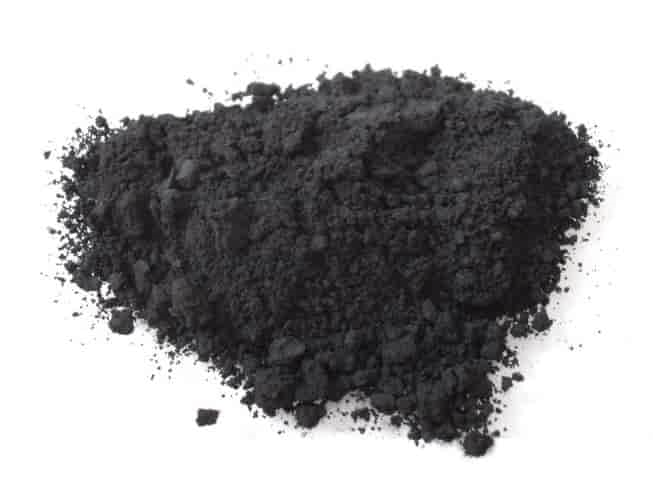Editor’s Note: Considering recently proposed New York legislation to ban the sale of carbon black within 2 years, Inkjet Insight has sponsored a series of articles to clarify what carbon black is, its uses in the printing industry and elsewhere, how it is produced, its potential environmental impact, and the viability of substitutes. Part 1 sets the stage with defining carbon black and its uses.
What is Carbon Black?
Raw carbon black is a fine powder composed of elemental carbon. The particles are agglomerates of stacked graphite-like crystals. It is produced through the partial combustion of hydrocarbons and characterized by small particle size, high surface area, and the ability to provide a deep black color. These properties and its low cost make it the leading black colorant used in various industries, including inks, paints, plastics, and rubber products.

Properties of Carbon Black
Some of the key physical properties of carbon black important for its use as a colorant in industrial inkjet and other forms of printing include particle size, shape, and color.
Particle Size
For inkjet applications, the particle size of carbon black needs to fall below one micron. Small particle size ensures smooth ink jetting through the nozzles of inkjet printheads and helps produce high-resolution prints. I like to see the largest pigment particle at least 20X smaller than the printhead nozzle diameter (typically ~20-25 microns) to avoid particle bridging in the printhead nozzles. A narrow particle size distribution is also important for consistent droplet formation, color, and print quality.
Surface Area
Carbon black pigment used in inks will have structure and high surface area, which enhances its ability to absorb and scatter light, leading to deeper and richer black colors. Although surface area is often measured in square meters per gram (m²/g), its typically reported by carbon black manufacturers in terms of an oil absorption number (OAN). The more oil a specific amount of pigment can take up, as measured by an Absorptometer, the higher the surface area. The OAN can vary and is an important piece of information for the ink formulator when preparing a high-quality black dispersion.

Color Properties
The “jetness” or blackness of the pigment refers to the depth and intensity of the black color produced. High jetness is desirable for producing rich, dark, prints. Although the blackness of an ink is hue dependent, I explain it as trying to achieve an ink with an L* value of less than one in the CIELAB color space. Some ink companies will add cyan pigment to a black ink to help achieve a deeper black.
Dispersion Stability
For inkjet inks, carbon black must be well-dispersed and remain stable in the finished ink to prevent color shift, poor image quality, or worse, clogging of the print heads. Specialty dispersants and careful formulation studies are required to achieve dispersion stability over time and under various storage conditions. Finding the optimal ratio of pigment, dispersant, and synergist in some cases, will deliver high density pigment dispersions which are low viscosity and stable over time. This is particularly important for high-speed and high-resolution industrial inkjet printers.
Use of Carbon Black Through Time
Long before inkjet, carbon black was used as a pigment. The Egyptians utilized carbon black to create inks for writing on papyrus scrolls, and it was a key ingredient in the production of black paints and cosmetics. The oldest known ink, used by the Chinese around 2500 BC, was made from soot (a form of lampblack) mixed with animal glue. The labor-intensive process produced black ink for calligraphy and art.

Figure 2.Twelve Plants and Calligraphy, detail of handscroll by Xu Wei, 16th century, Ming dynasty
Later in the 19th and early 20th centuries, the industrial revolution saw the expansion of carbon black production. A significant milestone was its introduction into the rubber industry for the manufacturing of tires. In 1910, the Goodrich Tire Company began adding carbon produced from the channel black process to rubber compounds to improve durability and wear resistance. This finer particle size black also protected the tires from UV degradation. Thus, carbon black pigment dramatically extended the lifespan of tires contributing to the growth of the automotive industry. And still today the tire industry is the largest consumer of carbon black.
The second half of the 20th century saw significant advancements in printing technology and carbon black played a major role. As inkjet printing technology emerged, the demand for high-quality, finely dispersed carbon black pigment increased.
In the 1990’s Hewlett-Packard (HP) and DuPont collaborated in the development of the first carbon black inkjet ink. DuPont through its expertise in chemistry and materials science produced a stable carbon black dispersion and ink. HP engineered the inkjet printing system and integrated the ink formulations into printers. The HP Deskjet 850c was launched in 1995. This partnership led to the first commercial inkjet printer using a pigment-based inkjet ink and demonstrated to the world pigments could be used in reliable inkjet ink formulations.

Continued innovations in particle size reduction, surface treatment, and dispersion techniques have enabled production of carbon black pigments that are used in high-resolution inkjet printers, leading to sharper images and text in printed materials.
Today, all major inkjet ink producers utilize carbon black to manufacture inks. Dye based inks pale in comparison when superior lightfastness, chemical resistance, and abrasion resistance are required. Pun intended. Carbon black’s unique properties, including high jetness, durability, fine particle size, make it indispensable in industrial inkjet printing. It enables high-quality and durable prints that meet the requirements of various industrial applications.
I recommend that you learn more about the recently proposed New York legislation, The Packaging Reduction and Recycling Infrastructure Act that includes a ban on the sale of carbon black. Following this introduction to the origins of carbon black, this series will continue with an overview of carbon black production and regulatory perspectives as well as a landscape view of potential carbon black substitutes.

